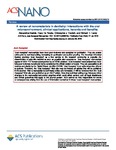Review of Nanomaterials in Dentistry: Interactions with the Oral Microenvironment, Clinical Applications, Hazards, and Benefits
| dc.contributor.author | Besinis, Alexandros | |
| dc.contributor.author | De Peralta, T | |
| dc.contributor.author | Tredwin, Christopher | |
| dc.contributor.author | Handy, Richard | |
| dc.date.accessioned | 2016-06-22T15:58:00Z | |
| dc.date.available | 2016-06-22T15:58:00Z | |
| dc.date.issued | 2015-03-24 | |
| dc.identifier.issn | 1936-0851 | |
| dc.identifier.issn | 1936-086X | |
| dc.identifier.uri | http://hdl.handle.net/10026.1/4943 | |
| dc.description.abstract |
Interest in the use of engineered nanomaterials (ENMs) as either nanomedicines or dental materials/devices in clinical dentistry is growing. This review aims to detail the ultrafine structure, chemical composition, and reactivity of dental tissues in the context of interactions with ENMs, including the saliva, pellicle layer, and oral biofilm; then describes the applications of ENMs in dentistry in context with beneficial clinical outcomes versus potential risks. The flow rate and quality of saliva are likely to influence the behavior of ENMs in the oral cavity, but how the protein corona formed on the ENMs will alter bioavailability, or interact with the structure and proteins of the pellicle layer, as well as microbes in the biofilm, remains unclear. The tooth enamel is a dense crystalline structure that is likely to act as a barrier to ENM penetration, but underlying dentinal tubules are not. Consequently, ENMs may be used to strengthen dentine or regenerate pulp tissue. ENMs have dental applications as antibacterials for infection control, as nanofillers to improve the mechanical and bioactive properties of restoration materials, and as novel coatings on dental implants. Dentifrices and some related personal care products are already available for oral health applications. Overall, the clinical benefits generally outweigh the hazards of using ENMs in the oral cavity, and the latter should not prevent the responsible innovation of nanotechnology in dentistry. However, the clinical safety regulations for dental materials have not been specifically updated for ENMs, and some guidance on occupational health for practitioners is also needed. Knowledge gaps for future research include the formation of protein corona in the oral cavity, ENM diffusion through clinically relevant biofilms, and mechanistic investigations on how ENMs strengthen the tooth structure. | |
| dc.format.extent | 2255-2289 | |
| dc.format.medium | Print-Electronic | |
| dc.language | en | |
| dc.language.iso | eng | |
| dc.publisher | American Chemical Society (ACS) | |
| dc.subject | nanoparticles | |
| dc.subject | protein corona | |
| dc.subject | biomaterials | |
| dc.subject | nanocomposites | |
| dc.subject | dental implants | |
| dc.subject | tooth chemistry | |
| dc.subject | dentine | |
| dc.subject | enamel | |
| dc.subject | calcium hydroxyapatite | |
| dc.subject | pulp stem cells differentiation | |
| dc.subject | infection control | |
| dc.subject | antibacterial activity | |
| dc.title | Review of Nanomaterials in Dentistry: Interactions with the Oral Microenvironment, Clinical Applications, Hazards, and Benefits | |
| dc.type | journal-article | |
| dc.type | Journal Article | |
| dc.type | Review | |
| plymouth.author-url | https://www.webofscience.com/api/gateway?GWVersion=2&SrcApp=PARTNER_APP&SrcAuth=LinksAMR&KeyUT=WOS:000351791800006&DestLinkType=FullRecord&DestApp=ALL_WOS&UsrCustomerID=11bb513d99f797142bcfeffcc58ea008 | |
| plymouth.issue | 3 | |
| plymouth.volume | 9 | |
| plymouth.publication-status | Published | |
| plymouth.journal | ACS Nano | |
| dc.identifier.doi | 10.1021/nn505015e | |
| plymouth.organisational-group | /Plymouth | |
| plymouth.organisational-group | /Plymouth/Faculty of Health | |
| plymouth.organisational-group | /Plymouth/Faculty of Health/Peninsula Dental School | |
| plymouth.organisational-group | /Plymouth/Faculty of Science and Engineering | |
| plymouth.organisational-group | /Plymouth/Faculty of Science and Engineering/School of Biological and Marine Sciences | |
| plymouth.organisational-group | /Plymouth/Faculty of Science and Engineering/School of Engineering, Computing and Mathematics | |
| plymouth.organisational-group | /Plymouth/REF 2021 Researchers by UoA | |
| plymouth.organisational-group | /Plymouth/REF 2021 Researchers by UoA/UoA03 Allied Health Professions, Dentistry, Nursing and Pharmacy | |
| plymouth.organisational-group | /Plymouth/REF 2021 Researchers by UoA/UoA06 Agriculture, Veterinary and Food Science | |
| plymouth.organisational-group | /Plymouth/REF 2021 Researchers by UoA/UoA12 Engineering | |
| plymouth.organisational-group | /Plymouth/Research Groups | |
| plymouth.organisational-group | /Plymouth/Research Groups/Marine Institute | |
| plymouth.organisational-group | /Plymouth/Users by role | |
| plymouth.organisational-group | /Plymouth/Users by role/Academics | |
| dc.publisher.place | United States | |
| dc.identifier.eissn | 1936-086X | |
| dc.rights.embargoperiod | Not known | |
| rioxxterms.versionofrecord | 10.1021/nn505015e | |
| rioxxterms.licenseref.uri | http://www.rioxx.net/licenses/all-rights-reserved | |
| rioxxterms.type | Journal Article/Review |


